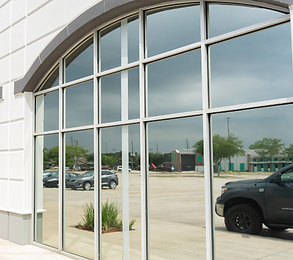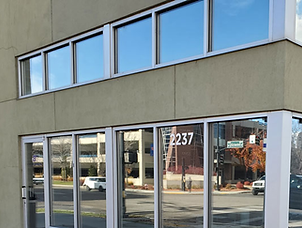Exterior Films
What is Exterior Film?
Tell me about Exterior Film?
Exterior film is a window tint specifically designed for application on the exterior surface of windows, sealed securely along all four edges. The film’s top layer features a durable hard coat with integrated UV blockers and solar control properties, often incorporating ceramic or metalized elements.
Exterior films are ideal for scenarios where interior films cannot or should not be applied. They provide exceptional heat reduction and serve as the first layer of protection for the exterior glazing in both residential and commercial projects.


Why choose Exterior film vs Interior
Exterior film has become an increasingly popular choice for residential projects due to its unique benefits. Unlike traditional reflective films, exterior ceramic window tints absorb heat rather than reflect it, making them especially suitable for homes with artificial turf. Reflected light from Low-E coatings can cause turf to melt, and exterior film helps prevent this issue.
Additionally, exterior window tint is often used in new constructions where certain windows, such as false dormers or attic windows, are inaccessible from the inside. These architectural challenges make applying interior film nearly impossible.
Exterior film not only delivers outstanding heat reduction and daytime privacy but also enhances the overall aesthetics of your home.

Residential Exterior Film
Commercial Exterior Film
Windows are often the most noticeable feature of many commercial buildings. In multi-tenant structures, variations in glass colors across units can create an inconsistent appearance. Over time, issues such as seal failure or imperfections in aging glass can detract from the building's aesthetic. Applying exterior film can create a clean, uniform look, instantly improving the building's exterior appeal.
In commercial spaces where walls are added to modify layouts, windows may become inaccessible from the interior. Exterior film provides a practical solution by offering privacy and concealing changes such as new wall additions or other structural updates. This not only maintains the building's visual harmony but also ensures functional and aesthetic benefits for occupants and visitors alike.

Exterior Brands that are great!




Types of Exterior Window Film
Reflective Exterior Window Film

Reflective exterior window films offer superior heat reduction while enhancing the building’s exterior with a sleek, uniform appearance. Available in various dark shades, they provide excellent glare reduction, ensuring a comfortable indoor environment.
These films are also highly effective at maintaining privacy and minimizing fading caused by UV exposure. By blocking up to 99% of UV rays, reflective window films help protect personal belongings, furniture, and flooring from sun damage.

Ceramic Exterior Window Film

Advantages of Ceramic Window Film
The key advantage of ceramic window film lies in its ability to absorb and dissipate heat, rather than redirect it like neutral or reflective tints. This makes it an excellent option in situations where reflectivity is a concern, such as preventing lawn or turf burning caused by reflected light. Unlike reflective films that can generate enough heat to melt plastics or synthetic materials, ceramic tints are non-reflective and safe for such applications.
Ceramic films are ideal for achieving significant heat reduction and UV protection. For instances where interior window access is limited or unavailable, exterior ceramic film serves as a highly effective solution, delivering all the benefits of ceramic technology in a durable, exterior-grade application.

Nuetral Exterior Window Film

Neutral exterior
Neutral exterior films are an excellent choice because they lack a high-reflective appearance. With a neutral color and moderate reflectivity, they seamlessly blend with their surroundings. These films provide a medium-level reflectivity, avoiding the shiny, high-reflective finish common in many other tinting products. Despite being less reflective, they still deliver impressive heat reduction performance.
Why customers love Neutral
The primary reason for installing neutral film is to safeguard your home's wood furniture, artwork, and upholstery from fading or sun damage. Prolonged exposure to harmful UV sunlight can lead to discoloration, fading, and the deterioration of natural materials like cotton and wool.

-
What does the window tint mean?The percentage is the amount of light that the window tint lets in. For example, if you have a window in your home or office with no tint, it’s letting in 100% light. When you apply a 35% film to the window, it’s only allowing 35% out of 100% of the light to come in. And, a 60% product will let in 60% of the light. The lower the number, the darker the film.
-
Is there a film that will allow you to see out day and night and give you privacy day and night?At this time, no. They have not figured that out. We can give great privacy during the day, but at nighttime, once you flip your lights on, it does not work.
-
How long will the window tint last?The most common and popular tint films use the CDF adhesives, those films last upwards of 30 years if they’re maintained correctly.
-
What is the process from the moment that the customer calls? What do you expect each step to be?We do an onsite free estimate where we evaluate the needs of the customer. During this time, we take a look at the job site, get measurements and show the customer samples of the tint. From there, we set up an install appointment where the crew will come out to cut the film down to fit each window. They use drop cloths and booties to protect the area during the cleaning and application process. We want to make sure that we’re respecting and protecting your property.
-
How long does it take to do the installation?On average, not counting ladder work, it takes about 20-35 minutes per pane to install the tint, depending on the type of window. For example, a 3,000 square foot home, two levels will take one to two days.
-
How do I pick the perfect shade of window tint?When picking out the shade, it’s all about what your needs are. Are you looking for heat reduction? Do you need privacy? Do you need glare reduction, fade reduction, etc? From there, once you’ve determined your needs, you can choose the best film type for you. Then, you can pick the shade of the film to determine how much light you want to let in.
Contact
Reach out today for your free onsite consultation

SEO Optimization Highlights
-
Keywords: "Heat Rejection Window Film," "Solar Heat Reduction Film," "UV Blocking Film for Windows," "Energy-Saving Window Film."
-
Meta Description: "Stay cool and reduce energy costs with heat rejection window film. Protect your interiors, block UV rays, and enhance comfort. Shop now!"
